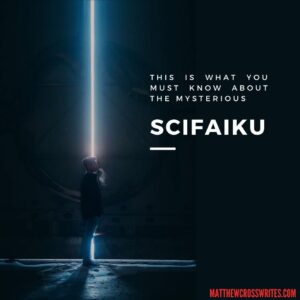
In simplest terms, SciFaiku is haiku poetry written about science fiction topics. “SciFaiku” is a mash-up of the words “Sci Fi” and “haiku.”
What is the SciFaiku Manifesto?
In 1995, Tom Brinck published his “SciFaiku Manifesto” on the internet. In the Manifesto, he proposes a new form of poetry based on haiku.
“SciFaiku takes its form from contemporary international haiku. A usual poem is 3 lines and contains about 17 syllables. The topic is science fiction. It strives for a directness of expression and beauty in its simplicity. Here is a representative example:

“Asteroids collide
“without a sound . . .
“We maneuver between fragments.”
How is SciFaiku different than haiku?
Brinck explains that haiku suggests the form of the poem, but SciFaiku stretches that form into something new.

“In striving for directness of expression, SciFaiku avoids abstract concepts and metaphors and describes rather than philosophizes. Leave the implications to the reader’s imagination:
“Like haiku, SciFaiku seeks terseness of expression. It is minimal and elegant. The standard length is 17 syllables. Traditional haiku is composed of 3 lines of 5, 7, and 5 syllables respectively. This is a useful guideline, but need not be followed strictly. More than 17 syllables is permissible if well-motivated. Fewer syllables or fewer lines are appropriate if the poem still successfully conveys a message.”
How to unleash powerful Sci Fi insights with SciFaiku
At the core of SciFaiku are three concepts:
- Expressing a deep or powerful insight
- Using the simplest expression
- Wrapping it in a Sci Fi theme
“Every poem needs to clearly evoke a science-fiction premise as well as express its own observation of that premise, and this is perhaps the most challenging aspect of writing SciFaiku.”
. . . .
“Perhaps one of the most intriguing aspects of science fiction is how it provides deep insight into the human condition, even when the subject matter is computers or aliens. Not restricting itself only to the tangible, SciFaiku permits an exploration of the thoughts and feelings of characters within a poem.”
Here are some examples of SciFaiku
Brinck has collected many great examples of SciFaiku on his website. Here are just a few samples:
Spring showers
Greg Pass – gregpass@cs.cornell.edu
my best friend
rusts.
Timetravel is forbidden.
Eva Eriksson – eva.eriksson@halmstad.mail.telia.com
But kids
do it anyway.
Magnetic tazer fanblades
Dave Richardson – KKZZ50A@prodigy.com
weave around each other
seeking your flesh.
OK, now I’m going to try one. Here goes:
Inner eyelids click
Matthew Cross
Beneath languid eyelashes.
She’s so into me.
Write your own SciFaiku!

Challenge yourself and your mind with SciFaiku
Before you try your hand at writing SciFaiku, here are a few final tips from Brinck:
“Imagery is often the finest point of all of them, not only the beautiful descriptions, but the ability to evoke an entire scene with just a few words. Subtlety and implication are the most powerful devices — the suggestion of a grander plan, a universal truth, or sometimes simply a personal truth that would otherwise go hidden. The language is also key. Most of these stick to the simplest of words, capturing very basic experience. Those that do go into technical terminology combine the terms into intricately beautiful patterns.”
Write your own SciFaiku and submit it below.
Be stellar!
Matthew Cross


